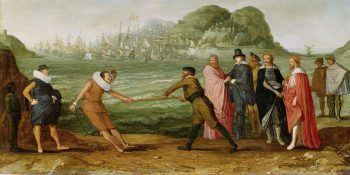Paul Strohm at Lapham’s Quarterly:
 Giano’s killing was one episode in the larger story of international trade and its accompanying rivalries in the later European Middle Ages. The so-called Dark Ages were never as dark as their name would imply; hucksters, peddlers, chapmen, and other minor players had always plied Europe’s roads and dealt their goods. But it was in the fourteenth and fifteenth centuries that high-volume international trading seriously resumed, with trade in wool one of its major drivers. In those centuries, the Port of London alone handled almost a thousand arriving and departing trading vessels a year, and numerous other English ports (including the newly active ports of Dover and Southampton) were claiming a role. Half this activity was devoted to wool, and it generated immense wealth for the realm, conferring fortunes on a small and monopolistic group of men. These successful profiteers were not the sheepherders and shearers of the provinces, nor the merchant sailors who braved the seas, but the entrepreneurial middlemen who collected revenues on exported wool. A close-knit group of at most several hundred men, they formed allegiances and confederations throughout the mercantile establishment that dominated the leading guilds and ran the city of London.
Giano’s killing was one episode in the larger story of international trade and its accompanying rivalries in the later European Middle Ages. The so-called Dark Ages were never as dark as their name would imply; hucksters, peddlers, chapmen, and other minor players had always plied Europe’s roads and dealt their goods. But it was in the fourteenth and fifteenth centuries that high-volume international trading seriously resumed, with trade in wool one of its major drivers. In those centuries, the Port of London alone handled almost a thousand arriving and departing trading vessels a year, and numerous other English ports (including the newly active ports of Dover and Southampton) were claiming a role. Half this activity was devoted to wool, and it generated immense wealth for the realm, conferring fortunes on a small and monopolistic group of men. These successful profiteers were not the sheepherders and shearers of the provinces, nor the merchant sailors who braved the seas, but the entrepreneurial middlemen who collected revenues on exported wool. A close-knit group of at most several hundred men, they formed allegiances and confederations throughout the mercantile establishment that dominated the leading guilds and ran the city of London.
more here.
